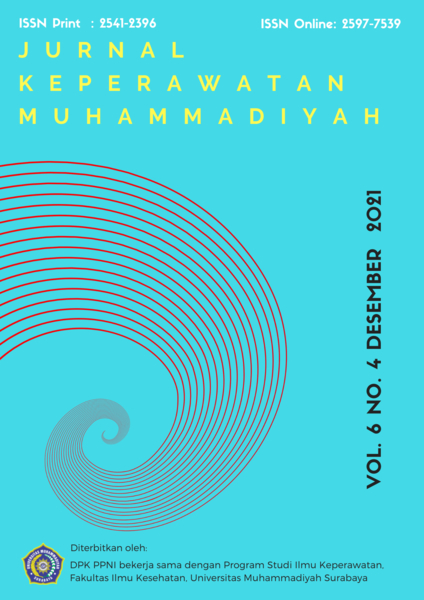Efektivitas Massase Anak Prasekolah terhadap Status Gizi
DOI:
https://doi.org/10.30651/jkm.v6i4.17398Keywords:
Effectiveness, massage, nutritional status, preschoolersAbstract
Objective: One indicator in determining a child's health is nutritional status. Good nutritional status can help the process of optimal growth and development of children. Handling malnutrition status can be done by giving the baby a balanced dietary intake through the mother by providing exclusive breastfeeding and baby massage, which the parents can do. This study aimed to determine the effectiveness of preschoolers' massage on nutritional status.
Methods: This research is in the form of Quasy Experimental using pre-test and post-test. The sampling technique uses accidental sampling. This research was conducted at PAUD 'Aisyiyah Sidotopo Wetan Surabaya in November 2021. This study examined massage (independent variable) and nutritional status (dependent variable). Nutritional status is an indicator in determining a child's health status by filling out the Towards Healthy Card (KMS), with poor and good categories. Massage for preschool children is a massage for children aged 3-6 years who are experiencing good nutrition and malnutrition. This massage was measured through observation, with the measurement results not being massage therapy and massage therapy. Data collection in this study used primary data, namely data collection obtained through direct interviews with the child's mother using interviews and observation. Data were analyzed by Paired sample test.
Results: The results of the study showed the effectiveness of massage on the nutritional status of preschoolers. The Wilcoxon Mann-Whitney statistical test showed a significant p-value of 0.01 (p <0.05)
Conclusion: This study concludes that massage is effective on nutritional status in preschool children. Health workers, especially midwives as providers of maternal and child health services, are expected to socialize by giving massage therapy.
References
Amalia, I. A. (2016). Aspek perkembangan motorik dan hubungannya dengan aspek fisik dan intelektual anak. AWLADY: Jurnal Pendidikan Anak, 2(1).
Amalia, L., Permatasari, I. I., Khomsan, A., Riyadi, H., Herawati, T., & Nurdiani, R. (2015). Pengetahuan, sikap, dan praktek gizi ibu terkait iodium dan pemilihan jenis garam rumah tangga di Wilayah Pegunungan Cianjur. Jurnal Gizi Dan Pangan, 10(2).
Amirullah, A., Putra, A. T. A., & al Kahar, A. A. D. (2020). Deskripsi status gizi anak usia 3 sampai 5 tahun pada masa Covid-19. Murhum: Jurnal Pendidikan Anak Usia Dini, 16–27.
Astuti, E. S., & Warastuti, W. (2014). Pengaruh Stimulasi Motorik Halus Terhadap Daya Konsentrasi Belajar Anak Usia Prasekolah. Jurnal Ilmu Pendidikan, 20(2).
Atari, S., Ballotta, M., Banda, M., Begin, F., Bränning, A., Buckanoff, M., Chai, J., Chen, X., Hayashi, C., & Heymann, J. (2018). Early Childhood Development. Early Childhood Development. Https://Doi. Org/10.4018/978-1-5225-7507-8.
Aziza, N. A., & Mil, S. (2021). Pengaruh Pendapatan Orang Tua terhadap Status Gizi Anak Usia 4-5 Tahun pada Masa Pandemi COVID-19. Golden Age: Jurnal Ilmiah Tumbuh Kembang Anak Usia Dini, 6(3), 109–120.
Chinyoka, K. (2014). Impact of poor nutrition on the academic performance of grade seven learners: a case of Zimbabwe. International Journal of Learning & Development, 4(3).
Fadila, Amareta, & Febriyatna. (2017). Hubungan Pengetahuan Dan Perilaku Ibu Tentang Gizi Seimbang Dengan Status Gizi Anak Tk Di DesaYosowilangun Lor Kabupaten Lumajang. Jurnal Kesehatan, 5(1), 14–20.
Fitriana, A. A. (2020). Pemahaman Orang Tua Mengenai Gizi Anak. Jurnal Pendidikan Modern, 5(3), 96–101.
Gustiana, A. D., & Puspita, R. D. (2020). The Effect of Educative Games on the Physical Fitness of Kindergarten Children. Jurnal Pendidikan Jasmani Dan Olahraga, 5(2), 149–154.
Hayati, M., Sudiana, I. K., & Kristiawati, K. (2014). Analisis Faktor Orang Tua terhadap status Gizi balita pendekatan Teori Health Belief Model. Pediomaternal Nursing Journal, 2(2).
Kadim, & Endyarni. (2016). Manfaat Terapi Pijat pada Konstipasi Kronis Anak (Vol. 12). Sari Pediatri.
Martorell, R. (2017). Improved nutrition in the first 1000 days and adult human capital and health. American Journal of Human Biology, 29(2), e22952.
Panjaitan, A. V. (2019). Gambaran Asuhan Energi, Protein, Zat Besi, dan Status Gizi Pada Remaja Di SMP Advent Lubuk Pakam.
Pratiwi, H. L., & Setyawati, V. A. V. (2014). Hubungan Asupan Energi dan Protein dengan Status Gizi Anak 1-5 Tahun di Posyandu Lestari IV Desa Kalipucangwetan Kecamatan Welahan Kabupaten Jepara Tahun 2014. Fak Kesehat Univ Dian Nuswantoro.
Soetjiningsih, C. H. (2018). Seri psikologi perkembangan: perkembangan anak sejak pembuahan sampai dengan kanak-kanak akhir. Kencana.
Suryana, D. (2016). Pendidikan Anak Usia Dini: Stimulasi & Aspek Perkembangan Anak. Prenada Media.
Wijayanti, N. (2017). Fisiologi Manusia dan Metabolisme Zat Gizi. Universitas Brawijaya Press (UB Press).
Downloads
Published
Issue
Section
License
- Penulis tetap memegang hak atas karyanya dan memberikan hak publikasi pertama kepada jurnal ini yang secara simultan karya tersebut dilisensikan di bawah:Â Creative Commons Attribution-ShareAlike 4.0 International (CC BY-SA 4.0)













